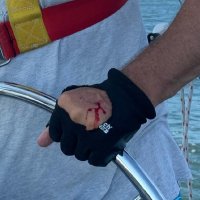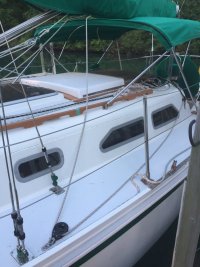Jibe technique is various and for good reason. I blame sailing schools for one size fits all "rules," but I can see why an unintended jibe is taught as dangerous.
What we're talking about here, the DDW jibe, is fairly obsolete. Today's racing boats now jibe reach to reach. The days of fleets of 70-footers neck and neck dead downwind, with enormous sym spinnakers and bloopers, are over. By the way, when I was mainsheet trrimmer (on and off) on Tenacious, we jibed DDW by trimming the mainsail a few feet first. Then somebody grabbed the heavy main sheet. As the boom came over he threw this 100-pound mass of line into the air--to prevent it fouling. Wham! Yahoo.
Jibing duels with traditional spinnakers were common in dinghies, where the boom usually just slams over. They still are. On the Soling I gave the mainsheet a flick and ducked. Jibing a Laser in 25 knots nobody tries to trim the main first--and that's a big sail. He keeps the delicate balance. He sails by the lee, feeling the impending leech curl. Lasers sail entire downwind legs by the lee, with the boom 10 degrees forward of athwartship. The jibe is a small move of the tiller, and as the boom comes over a small move of the tiller the other way to offset the new heeling force. The idea is to keep the mast vertical, and the experts can. I usually couldn;t, and in 20 knots wound up in a broach with mast in water. I did win a race that way, intentionally broaching and putting the mast in the water every jibe. Everybody else tried to jibe with elegance--and turned upsidedown, which among Laser racers is considered slow.
Where was I? It is true of both planing dinghies, ocean racers and our boats that a DDW jibe depends on the helmsman. And no "one size for all."
I think of myself as a singlehander because usually, on the E381 without a racing crew, that;s what I effectively am. When I jibe, I can;t ask an inexperienced hand to trim the mainsail half way in, then, as the boom comes over, let it out hand over hand to ease the transition. That simple move takes a bit of experience. In 30 knots it takes a lot of experience not to get hurt.
"One size." On the E38, I'm behind the wheel and the main sheet is 10 feet away. It isn;t practical to both steer and work the main sheet. So how does a singlehander jibe in 30 knots? Most use the J turn. Actually, with two reefs in the slam-over is trivial. Sure, the mainsheet usually fouls. Clear that whenever, it doesn't matter anyhow. This jibe procedure would seem awkward or worse in a lake, but it's the only way for a singlehander offshore and it works fine. It is actually a very unattractive prospect to consider coming about in 20-plus trade winds and ten foot cresting seas, to de-rig the whisker pole, reset the genoa, and then attempt to bash close hauled through the eye of the wind. Jibing is easy and fast.
Yes, when something goes wrong the boat broaches and maybe puts the spreaders in the water, but boats are built for that. My pals in the SSS races claim they put spreaders in the water a few times each Hawaii race (Brian, Olson 34; Steve, Islander 36). And they are singlehandedly jibing spinnakers, not just a winged-out jib. Sleeping offshore DDW I usually broach half a dozen times en route Hawaii. You come on deck groggy and everything's backwards up there. Why so many broaches? Because vane steering can't anticipate gusts or a random diagonal crest against the fantail.
Which brings us to preventers. I always rig one. What a joke. You jibe and broach and now the boom is held against the wind, sail inside out, while the yacht wallows. There's huge force on the preventer line, which is usually just a "safety line" around a cleat. OK, now you have to release the preventer before you can do anything, with waves breaking on your head. I think I've had it with preventers and next cruise will not rig one. Let the boom choose which side of the boat it wants to be on.
But one size doesn;t fit all. Most of the time, on a family cruise, a preventer is there to prevent the boom from knocking all the children off the cabin house in an accidental jibe. Now that makes sense. Would a boom brake also prevent that? I don't know, but if not don;t you need a preventer too?
I think in reality an accidental jibe happens less than we think. It is always a lapse of helmsmanship. Radical wind shifts do happen, but mostly in known conditions such as picking your way through a fluky breeze, or under cliffs, or coming out from under a lee. Most of us are alert then in proportion to the number of times we have been caught by surprise, and it only takes one or two of those.
The most likely cause of an accidental jibe is an inattentive helmsperson. DDW is the rare course where it's probably not a good time to put a kid at the wheel. For all of us it;s a good time to recognize how much attention, and strength, it takes to steer a course if the boat isn;t balanced, and to experiment with the sails until balance is achieved.
A balanced boat makes DDW a pleasure to sail. You gently correct as waves raise the stern, you enjoy the surf, you gently correct as she slows and slews. In a steady breeze it's easy. In a blow it's work. On a casual afternoon sail it still takes attention, and that's on us.



